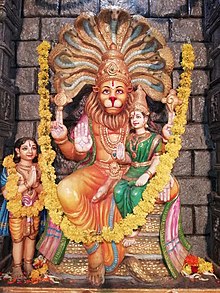Lakshmi Narasimha (Sanskrit: लक्ष्मीनरसिंह, romanized: Lakṣmīnarasiṃha) is an iconographical depiction of Narasimha, the fourth avatarofVishnu, with his consort Lakshmi, the goddess of prosperity.[1] It is one of the five iconographical forms of Narasimha, among Jvala Narasimha, Gandaberunda Narasimha, Ugra Narasimha, and Yoga Narasimha.[2]
| Lakshmi Narasimha | |
|---|---|
God of Time | |

Lakshmi Narasimha with Prahlada
| |
| Venerated in | Vaishnavism |
| Affiliation | Sri Vaishnavism |
| Abode | Vaikuntha |
| Festivals | Narasimha Jayanti |
In an alternate iteration of the legend of Narasimha, after he slays Hiranyakashipu, his fury is still unabated. The deity is enraged that his virtuous devotee, Prahlada, is traumatised by the violent deeds of his own father. Despite the fact that the devas sing his praises and extol his glories, he remains unpacified. The devas proceed to pray to Lakshmi, who appears before her consort. She soothes Narasimha, assuring him that both his devotee and the world had been saved. Hearing his wife's words, the deity is pacified, and his appearance also becomes more benign. As a result, Lakshmi Narasimha is venerated as a representation of gentleness and peace.[3]
Narasimha is depicted with his consort Lakshmi, seated on his lap.[4] In contrast to his ugra (terrible) aspect, where his face is contorted and enraged, he appears to be serene in this form.[5] He often carries his aspects of the Sudarshana Chakra and Panchajanya, and his murti is decorated with ornaments and garlands.[6]
In the Tiruppavai, the mythical motif of the lion is invoked in the representation of Lakshmi Narasimha. The deity is regarded to be magnanimous, the greatest of all beings (Purushottama), and his heart is symbolised by his consort, Lakshmi.[7]